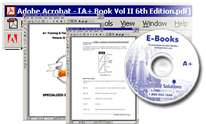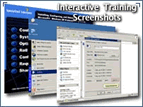| |
|
|
Multi User Training
|
|
| Full online Library |
| Windows Server 2008 |
| |
| Windows Server 2003 |
Web Developer
|
| SQL Server |
| Help Desk Support |
| MS Office |
| CompTIA Training |
| |
| Cisco Training |
|
Other Course
|
|
| |
| |
|
|
|
 |
|
 |
|
|
 |
 |
 |
 |
 |
 |
![]() |
 |
|
MCTS 70-433 SQL Server 2008 Database Developer Training
With Microsoft SQL server database technology growing by leaps and bounds there is an increasing demand for Microsoft Certified Technology Specialists. The MCTS SQL server 2008 course enables you to create databases and database files, use XML-related features in Microsoft SQL Server 2008, Plan, create, and optimize indexes, etc. If you choose to be a specialist in database management as administrators and developers, then this is the course for you.
You get first hands-on training in Implement data integrity in Microsoft SQL Server 2008 databases using constraints, triggers, and XML schemas. You can also configure Database Mirroring, monitoring the SQL Server, overview of replication scenarios, while viewing your current activity. So if you choose to be an excellent business intelligence developer or a database administrator, then MCTS SQL 2008 is the course for you
|
|
 Audience: Audience: |
| |
Candidates should have experience using Microsoft SQL Server 2008 or experience using a previous version of SQL Server. Candidates for this exam are IT professionals who work in jobs in which database development is their main area of responsibility, or they work in environments in which databases are central to their primary job roles
|
 |
Our
easy-to-use delivery format
allows you to concentrate
on the lesson at hand
and not how to run the
delivery software - saving
you time and frustration.
Our comprehensive course
materials are delivered
in an easy-to- understand
format - allowing you
to get the most out of
your time. |
 |
Our courses incorporate
audio, video, and text
training and then the
total experience is
reinforced with exercises
and practice tests to
ensure that you have
really grasped the material. |
|
|
|
 |
 |
 |
|
|
 |
 |
 |
 |
|
 |
|
|
 |
 |
 |
|
|
|
 |
|
|
|
|
|
|
 |
|
 |
 |
 |
|
 |
 |
 |
 |
 |
![]() |
 |
|
| |
(Learning Segments) |
|
|
| |
Implementing Tables and Views
-
Create and alter tables.
This objective may include but is not limited to: computed and persisted columns; schemas; scripts to deploy changes to multiple environments, for example, dev, test, production; manage permissions (GRANT, DENY, REVOKE)
-
Implement data types.
This objective may include but is not limited to: FILESTREAM; spatial, structured, and semi-structured; collations
-
Implement partitioning solutions.
This objective may include but is not limited to: partitioned tables and indexes (constraints, partition functions, partition schemes, MERGE, SPLIT, SWITCH); distributed partitioned views (constraints, linked servers)
Implementing Programming Objects
-
Create and alter stored procedures.
This objective may include but is not limited to: table-valued parameters (TVPs), EXECUTE AS, RECOMPILE, parameter direction (output); WITH ENCRYPTION; manage permissions (GRANT, DENY, REVOKE)
-
Create and alter user-defined functions (UDFs).
This objective may include but is not limited to: WITH SCHEMABINDING, EXECUTE AS; manage permissions (GRANT, DENY, REVOKE)
-
Create and alter DML triggers.
This objective may include but is not limited to: INSERTED, DELETED, INSTEAD OF, EXECUTE AS
-
Create and alter DDL triggers.
This objective may include but is not limited to: enabling/disabling; return event data
-
Create and deploy CLR-based objects.
This objective may include but is not limited to: permission sets (SAFE, UNSAFE, EXTERNAL_ACCESS), SET TRUSTWORTHY
-
Implement error handling.
This objective may include but is not limited to: TRY/CATCH, RAISERROR, retrieving error information, custom error messages, @@ERROR
-
Manage transactions.
This objective may include but is not limited to: BEGIN TRANSACTION, COMMIT, ROLLBACK, SET TRANSACTION ISOLATION LEVEL
Working with Query Fundamentals
-
Query data by using SELECT statements.
This objective may include but is not limited to: LIKE, WHERE, ORDER BY, INTO
-
Modify data by using INSERT, UPDATE, and DELETE statements.
This objective may include but is not limited to: row constructors, DELETE FROM FROM, UPDATE FROM, TRUNCATE TABLE
-
Return data by using the OUTPUT clause.
This objective may include but is not limited to: INSERTED, DELETED, INTO
-
Modify data by using MERGE statements.
This objective may include but is not limited to: INSERTED, DELETED, OUTPUT
-
Implement aggregate queries.
This objective may include but is not limited to: built-in aggregate functions, GROUPING SETS, GROUP BY, HAVING
-
Combine datasets.
This objective may include but is not limited to: CROSS APPLY, OUTER APPLY, all join types; UNION, UNION ALL, INTERSECT, EXCEPT
-
Apply built-in scalar functions.
This objective may include but is not limited to: CAST and CONVERT; REPLACE; LEN and DATALENGTH; PATINDEX and CHARINDEX
Applying Additional Query Techniques (15 percent)
-
Implement subqueries.
This objective may include but is not limited to: simple, correlated, scalar, list, table valued
-
Implement CTE (common table expression) queries.
This objective may include but is not limited to: recursive, non-recursive
-
Apply ranking functions.
This objective may include but is not limited to: RANK, PARTITION BY, DENSE_RANK, OVER, ROW_NUMBER, NTILE
-
Control execution plans.
This objective may include but is not limited to: table hints, query hints
-
Manage international considerations.
This objective may include but is not limited to: collations, defining custom errors, filtering data, sort order, nvarchar, database collation, column collation
Working with Additional SQL Server Components
-
Integrate Database Mail.
-
Implement full-text search.
This objective may include but is not limited to: CONTAINS, CONTAINSTABLE, FREETEXT, FREETEXTTABLE, STOPLIST
-
Implement scripts by using Windows PowerShell and SQL Server Management Objects (SMOs).
This objective may include but is not limited to: cmdlets
-
Implement Service Broker solutions.
This objective may include but is not limited to: services, queues, messages, message types, message validation, contracts, activation procedures
-
Track data changes.
This objective may include but is not limited to: change tracking; database audit specification; CHANGETABLE
Working with XML Data
-
Retrieve relational data as XML.
This objective may include but is not limited to: FOR XML
-
Transform XML data into relational data.
This objective may include but is not limited to: OPENXML, sp_xml_preparedocument, sp_xml_removedocument
-
Query XML data.
This objective may include but is not limited to: XQUERY, XPATH
-
Manage XML data.
This objective may include but is not limited to: XML datatype, XML indexes, XML schema collections
Gathering Performance Information
-
Capture execution plans.
This objective may include but is not limited to: graphical execution plans; SHOWPLAN
-
Gather trace information by using the SQL Server Profiler.
-
Collect output from the Database Engine Tuning Advisor.
This objective may include but is not limited to: prepare a workload
-
Collect information from system metadata.
This objective may include but is not limited to: Dynamic Management Views (DMVs), catalog views
|
|
|
|
|
|
|
 |
 |
 |
 |
 |
|
|
|
 |
 |
 |
 |
|
|
 |
![]() |
 |
|


|
 Full
motion video
Full
motion video
Each class is presented in
full motion video allowing
you to see the steps, hear
the explanations, and perform
the tasks which includes our
interactive hands-on training
simulations, students will
learn from real-world scenarios
taught by our expert instructor.
 Instructor-Led
Training
Instructor-Led
Training
Combines both the convenience
and affordability of computer-based
training with the effectiveness
of a traditional classroom
setting. The instructors featured
in our multi-media DVD's are
not only certified in their
area of expertise, but also
have years of real world experience
and are subject matter experts
in their fields. |
 |
 |
 E-BOOKS
(PDF) E-BOOKS
(PDF)
We supply a complete line
of e-books to offer a complete
training solution. Our courses
include e-books for CompTIA,
CISCO and Microsoft certifications.Supplied on DVD for DVD courses or downloadable for Online Courses. |
 |

|
 Practice
Exam Simulators Practice
Exam Simulators
We offer
exam simulators for
all technical certifications.
Our exam simulators
are the closest replication
to the real exam!
Our exam simulators creates
a simulation of an actual
certification exam. Under
timed conditions, IntelliSage?
sets up a test with 60
randomly chosen questions
designed to help you get
ready for the real exam.
As with the Practice Exam,
the Certification Simulator
allows you to mark questions
you cannot answer for
review at the end of the
test.
If you ask, IntelliSage?
will show you the correct
answer. IntelliSage? will
also explain why it is
the correct answer when
you select the "Learn
Now" feature. The Practice
Exam is the first IntelliSage?
step in getting you ready
to pass your certification
exams. |
 |
 |
 |
 Hands-on
Lab Simulation Hands-on
Lab Simulation
Hands-on Lab Simulation
is a crucial component
of your IT training. Practice make perfect. Step-by-step hands-on
labs with detail instructions
are included to reinforce
all key concepts. When
you complete a topic,
choose the Lab Simulation
button to select the associated
hands-on lab exercises.
Labs allow you to reinforce
concepts by performing
the tasks you've just
learned.. |
 |
 |
 |
 Free
Upgrades Free
Upgrades
A unique benefit of the our
Learning System, is that
it allows you to stay current
with the ever-changing certification
requirements. When a certification
test changes and we produce
an upgrade for the certification
program, we offer our customers
free upgrades on their interactive
DVD's for up to 1 year
from date of original purchase?
absolutely free! |
| |
|
|
 |
MCTS 70-433 SQL Server 2008 Database Developer Training
|
|
|
|
|
|
|
|
|
|
|
|
|
 |
|
|
|
|
 |
 |
 |
|
|
 |
|
 |
 |
 |
|
 |
 |
 |
|
|
 |
 |
 |
 |
 |
 |
|


